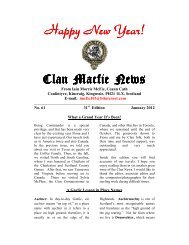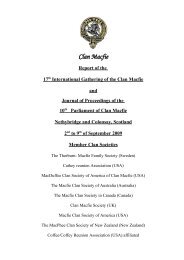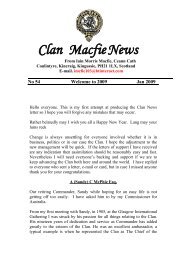Mythology, traditions and history - The Clan Macfie Society
Mythology, traditions and history - The Clan Macfie Society
Mythology, traditions and history - The Clan Macfie Society
You also want an ePaper? Increase the reach of your titles
YUMPU automatically turns print PDFs into web optimized ePapers that Google loves.
- 36 -<br />
immigrants from Maryl<strong>and</strong> <strong>and</strong> Virginia, but the secret arrangements•by Napoleon with Spain<br />
made the future of Louisiana uncertain. <strong>The</strong> role of Jefferson in obtaining, by purchase, this<br />
great area for incorporation into United States opened up a floodgate after 1803.<br />
<strong>The</strong>re was trouble with Mexico over Texas, New Mexico, Arizona <strong>and</strong> southern California.<br />
When these areas were incorporated into the United States of America, by 1850, another route<br />
to the Pacific was created. From 1855 Slovenes, Lithuanians <strong>and</strong> Greeks came through Gulf<br />
ports. When mining was developed in Arizona some Scots, Welsh <strong>and</strong> Irish immigrants were<br />
added to the rapidly growing population in California.<br />
In general, as Dr. Jones 1 points out the Germans, Norwegians, Swedes, Danes, Finns <strong>and</strong><br />
Russians l<strong>and</strong>ed on the Atlantic coast.<br />
Rowl<strong>and</strong> Berthoff 2 points out that from 1865 the State governments of the southern states<br />
were opposed to immigration, despite the fact that farmers wanted them to replace the "lazy<br />
negro". <strong>The</strong> Southerners, he contends, prided themselves on an Anglo-Saxon heritage, <strong>and</strong><br />
particularly opposed imports of Mediterranean labor, but few immigrants came to them from<br />
the north of Europe or from Britain. Berthoff <strong>and</strong> Harrison Johnson agree that the former<br />
Confederate States had only 2% of their population of "foreign birth" whereas other states had<br />
percentages up to 20%.<br />
Harrison Johnson 3 made a study of the intended destination of immigrants coming through<br />
Gulf ports for the years 1855-1878. <strong>The</strong>se immigrants had planned to settle from North<br />
Carolina <strong>and</strong> Kentucky to the Mississippi River in a number of 33,294; 11,799 had planned to<br />
settle to the west of the river. (This is what had happened elsewhere; when immigrants moved<br />
from Europe most persons settled in established areas while the second <strong>and</strong> third generations<br />
moved to new areas.) Of the 35,1314 persons whom Dr. Harrison studied 18% planned to<br />
remain in Tennessee, approximately the same percentage wise as planned to settle in Louisiana.<br />
Routes to the Pacific<br />
Thus far we have noted the appearance of members of our clan in the Atlantic States, or<br />
roughly, on the eastern side of the Alleghenies, with a few movements over the Cumberl<strong>and</strong><br />
Gap to Kentucky acid Tennessee.<br />
Louis B. Wright points a fanciful picture concerning western migration. He assumes, that<br />
the members of the Board of Trade, in London, sat around a table examining the eastern sea<br />
board on the American continent. <strong>The</strong>y drew a long line along the crest of the Alleghenies <strong>and</strong><br />
declared that this was the "Proclamation Line". Everything to the west of this line would be an<br />
Indian Reservation. Those whites who had moved into this area were to be ordered to move<br />
out, <strong>and</strong> no permits would be considered for the Europeans <strong>and</strong> colonists who decided that they<br />
would like to "move west". (<strong>The</strong> Atlantic Frontier, Colonial American Civilization, 1607-<br />
1763).<br />
1 Jones, M.A.; American Immigration, Chicago, 1960<br />
2 Berthoff, Rowl<strong>and</strong> T.; Southern attitudes toward Immigration, 1865-1914. J. of South. Hist.<br />
17, 1951, pp. 328-360<br />
3 Johnson, Harrison; Op. cit. pp. 165-166






